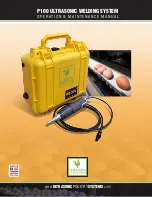
16
11. TROUBLE SHOOTING
The most common problems and their solutions are listed below:
DEFECT
CAUSE
SOLUTION
Welder does not start.
1) Make sure that there is voltage in
the supply mains
1) Switch-on the supply mains
The wire does not feed
when the wire-feeder rol-
ler rotates
1) Dirt on the tip of the wire-feeder
1) Blow with compressed air, replace nozzle
2) Excessive spool torque.
2) Loose
3) Faulty torch.
3) Check wire-feeder liner.
Jerky or intermittent wire-
feed.
1) Faulty gas nozzle.
2) Replace
2) Scorched gas nozzle.
2) Replace
3) Dirt in wire-feeder roller groove.
3) Clean
4) Worn wire-feeder roller groove
2) Replace
Arc cut-out
1) Loose earth clamp grip.
1) Tighten clamp grip
2) Short circuit between contact nozz-
le and gas hose.
2) Clean or replace contact nozzle and
wire-feed nozzle
Welder cuts out after pro-
longed use
1) Unit overheated and thermal protec-
tion device has set in
1) Leave the unit to cool down for at least
1-20 minutes.
Porous welds
1) Lack of shielding gas caused by
build-up in gas nozzle
1) Clean away build-up
2) Incorrect torch angle
2) The air gap between the torch and the
workpiece must be 5-10 mm. Ensure 60° torch
angle.
3) Gas shortage
3) Increase gas flow
4) Damp workpieces
4) Dry workpieces with hot-air gun or such-
like
5) Welding Arc too long
5) Shorten the arc
Hot cracks
1) Damp workpieces
1) Clean
2) Welding with very high heat supply
2) Decrease the welding current
3) Impure welding wire
3) Change the welding wire
4) Base material with high content of
carbon, sulphur and other imputities
Insufficient penetration
1) current too low
1) increase the current
2) Inconstant wire feeding
2) See the above paragraph
3) Edges too apart from each other
4) Bevel too small
Insufficient melting
1) Abrupt movements of the torch
1) Move the torch smoothly.
2) Non-optimized inductance value
2) Change the inductance value.
3) Oxidized workpieces
3) Clean
Lateral indentations
1) Excessive welding speed
1) Decrease the welding speed
Breakages
1) Unsuitable wire
1) Change the type of wire
2) Bad quality of the workpieces
Excessive splashes
1) current too high
1) Decrease the current value
2) Non-optimized inductance value
2) Increase the inductance value
3) torch too inclined
3) Straighten the torch
Summary of Contents for TM 215
Page 1: ...Instructionsmanual TM215 ...
Page 3: ......
Page 4: ...1 6 5 A 2 2 2 5 V 1 4 0 A 2 5 6 V 1 2 0 A 2 4 9 V 3 1 1 V 1 7 2 V 2 0 5 V 1 3 0 A ...
Page 6: ......
Page 11: ......
Page 12: ......
Page 13: ......
Page 14: ......
Page 15: ......
Page 16: ......
Page 19: ......
Page 24: ... NOTE ...
Page 25: ... NOTE ...
Page 26: ... NOTE ...
Page 28: ......







































